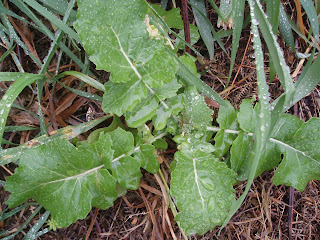 A member of the Brassicaceae family - which gives us many of our cultivated veges and condiments - broccoli, cabbage, kale, bok choi, radishes, turnips, cress, horseradish, wasabi, mustard, and on the list goes!
A member of the Brassicaceae family - which gives us many of our cultivated veges and condiments - broccoli, cabbage, kale, bok choi, radishes, turnips, cress, horseradish, wasabi, mustard, and on the list goes!Recognise this family (also called the mustard family or the cabbage family) by its four-petalled flowers with six stamens. They have flower heads that look like little broccoli heads when budding.
Most wild Brassicaceae are edible - but avoid gathering them from places that may have been heavily fertilised or be subject to run-off, as the plant absorbs and retains nitrates - toxic in high doses.
Family relationships
Wild turnip is just one variety - or subspecies- of Brassica rapa. Cultivated turnips are of this same species - and so is bok choy.
Ways to eat wild turnip
(The information here is the same as for wild radish, as they are so similar.)
Edible parts of wild turnip include the leaves (especially the younger, less bitter ones), the flowers, the flower buds, the roots, and the seeds.
Use the leaves just like bok choy leaves. They lose volume very quickly when cooked though, so you only need to fry or steam them for a few seconds. They lose a lot of their distinctive taste and hotness as they cook too, so that's another reason to keep it to the minimum.
Some young, small roots may be tender enough to cook and eat - give it a go. The larger ones will almost certainly be quite fibrous. They go well in stock though - just like their cultivated counterparts.
You can cook the flower buds like broccoli - but again only for the briefest time.
The flowers are decorative in salad.
To harvest the seeds, gather the seed pods after flowering and spead them out on a plate to dry in the sun. (It should be sunny by the time the pods appear!) As the pods dry, they'll split and release the seeds, which you can then easily separate from the pods and pour into a bowl or jar to store. Use them just like mustard seeds.
(To make mustard paste pound them up with a little liquid. Use vinegar if you want the paste to keep.)
(Thanks to Julia Stace Brooke-White for clearing up some of my confusion over what is and isn't wild turnip.)
Wild turnip links:
Plants for a Future database
Google Images








1 comment:
Appreciating the persistence you put into your blog and the detailed information you provide. Keep up the good work.
injection moulding company malaysia
packaging biskut raya malaysia
plastic cup manufacturer in malaysia
Post a Comment